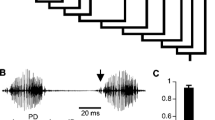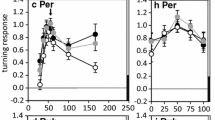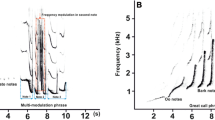Abstract
-
1.
The ontogeny of positive phono taxis (PPT) in female crickets, Gryllus bimaculatus was followed in tethered flight. During the first day of adult life many females already demonstrated PPT to the calling song (CS) of conspecific males. The average threshold of PPT at 5 kHz, the dominant frequency of the CS, decreased by 30 dB by the time of sexual maturity (Fig. 1).
-
2.
No correlates of this decrease were found in the activity of the most sensitive ascending prothoracic neuron tuned to 5 kHz recorded in the neck connective. This is presumably the AN1 neuron which is known to be involved in PPT realization. Its threshold at 5 kHz in young animals was the same as in adults. Therefore, ascending circuits of PPT seem to be mature by the first day of imago life and there should be some other mechanisms preventing performance of PPT by young walking females until maturation.
-
3.
The PPT of females in flight is tuned to 5 kHz, much sharper than in walking (Fig. 2). In flight, the carrier frequency of a signal is probably an important parameter driving PPT, at least in a no-choice situation, whereas on the substrate, at close range, temporal parameters become decisive.
-
4.
The ontogenetic development of the selectivity of a female's PPT to temporal parameters of a signal passes 3 successive steps: 1) response mainly to the trill with pulse repetition rate as in the CS; 2) response mainly to the actual CS with chirp structure; 3) destruction of selectivity (Figs. 3–6). The existence of steps 1 and 2 strengthens our hypothesis, that in phylogeny, the trill (pulse rate) detector of the CS “recognizer” in the CNS appeared earlier, and was later accompanied by the chirp detector.
-
5.
Joint breeding of female larvae with males accelerates maturation of the CS recognizer.
Similar content being viewed by others
Abbreviations
- CS:
-
calling song
- PPT:
-
positive phonotaxis
References
Alexander RD (1962) Evolutionary change in cricket acoustic communication. Evolution 16:443–467
Atkins G, Henley J, Handysides R, Stout J (1992) Evaluation of the behavioral roles of ascending auditory interneurons in calling song phonotaxis by the female cricket (Acheta domesticus). J Comp Physiol A 170:363–372
Bentley DR (1969) Intracellular activity in cricket neurons during generation of song patterns. Z Vergl Physiol 62:267–283
Doherty JA (1985a) Temperature coupling and trade-off phenomena in the acoustic communication system of the cricket, Gryllus bimaculatus De Geer (Gryllidae). J Exp Biol 114:17–35
Doherty JA (1985b) Phonotaxis in the cricket, Gryllus bimaculatus De Geer: comparisons of choice and no-choice paradigms. J Comp Physiol A 157:279–289
Doolan JM, Pollack GS (1985) Phonotactic specificity of the cricket Teleogryllus oceaniens: intensity-dependent selectivity for temporal parameters of the stimulus. J Comp Physiol A 157:223–233
Doolan JM, Young D (1989) Relative importance of song parameters during flight phonotaxis and courtship in the bladder cicada Cystosoma soundersii. J Exp Biol 141:113–131
Huber F (1962) Central nervous control of sound production in cricket and some speculation on its evolution. Evolution 16:429–442
Huber F, Moore TE, Loher W (eds) (1989) Cricket behavior and neurobiology. Cornell Univ Press, Ithaca London
Moiseff A, Pollack GS, Hoy RR (1978) Steering responses of flying crickets to sound and ultrasound: mate attraction and predator avoidance. Proc Natl Acad Sci USA 75:4052–1056
Nolen TG, Hoy RR (1984) Initiation of behavior by single neurons: the role of behavioural context. Science 226:992–994
Nolen TG, Hoy RR (1986) Phonotaxis in flying crickets. I. Attraction to the calling song and avoidance of bat-like ultrasound are discrete behaviours. J Comp Physiol A 159:423–440
Orbeli LA (1938) Lectures on physiology of the nervous system. Medgis, Moscow Leningrad (In Russian)
Orbeli LA (1939) Concepts of evolutionary physiology. Archiv Biol Nauk 61:43–55 (In Russian)
Pollack GS (1986) Discrimination of calling song models by the cricket, Teleogryllus oceanicus: the influence of sound direction on neuronal encoding of the stimulus temporal pattern and on phonotactic behaviour. J Comp Physiol A 158:549–561
Pollack GS, Hoy RR (1979) Temporal pattern as a cue for species-specific calling song recognition in crickets. Science 204:429–432
Pollack GS, Hoy RR (1981) Phonotaxis to individual rhythmic components of a complex cricket calling song. J Comp Physiol 144:367–373
Pollack GS, Plourde N (1982) Directionality of acoustic orientation in flying crickets. J Comp Physiol 146:207–215
Popov AV (1972) Sound signals of crickets (Orthoptera, Gryllidae) from the southern regions of the European part of the USSR. Entom Rev USSR 51/1:17–36 (In Russian)
Popov AV (1975) On the biology of field crickets: coustic behaviour and migrations. Zool J 54/12: 1803–1809 (In Russian)
Popov AV (1985) Acoustic behaviour and hearing in insects. Nauka, Leningrad (In Russian)
Popov AV, Markovich AM (1982) Auditory interneurons in the prothoracic ganglion of the cricket, Gryllus bimaculatus II. A high frequency ascending neuron (HF1AN). J Comp Physiol 146:351–359
Popov AV, Sergejeva MV (1988) Ontogenetic changes of positive phonotaxis in the cricket Gryllus bimaculatus. J Evol Biochim Physiol 24/2:210–216 (In Russian)
Popov AV, Shuvalov VF (1977) Phonotactic behaviour of crickets. J Comp Physiol 119:111–126
Popov AV, Shuvalov VF, Svetlogorskaya ID, Markovich AM (1974) Acoustic behaviour and auditory system in insects. Abh Rheinisch-Westf Akad Wiss 53:281–306
Popov AV, Michelsen A, Lewis B (1993) Changes in the mechanics of the cricket ear during the first days of adult life. Submitted to J Comp Physiol A
Rheinlaender J, Kalmring K, Popov AV, Rehbein HG (1976) Brain projection and information processing of biologically significant signals by two large ventral-cord neurons of Gryllus bimaculatus De Geer (Orthoptera, Gryllidae). J Comp Physiol 110:251–269
Sakaluk SK (1982) Onset of phonotaxis and age at first mating in female house cricket, Acheta domesticus (Orthoptera: Gryllidae). New York Entomol Soc 90:136–141
Schildberger K (1984) Temporal selectivity of identified auditory neurons in the cricket brain. J Comp Physiol A 155:171–185
Schildberger K, Hörner M (1988) The function of auditory neurons in cricket phonotaxis. 1. Influences of hyperpolarization of identified neurons on sound localization. J Comp Physiol A 163:621–631
Sergejeva MV, Popov AV (1987) Ontogenetic changes of phonotaxis and their neurophysiological correlates in the cricket Gryllus bimaculatus (negative phonotaxis). J Evol Biochim Physiol 21/1:58–67
Sergejeva MV, Popov AV (1990) Ontogenesis of phonotaxis in female crickets, Gryllus bimaculatus. In: Sensory systems and communication in arthropods, advances in life science. Birkhäuser, Basel, pp 335–340
Shchekanov EE, Shuvalov VF, Popov AV (1992) Ontogenetic changes in frequency selectivity of the peripheral auditory system in the cricket Gryllus bimaculatus. J Evol Biochim Physiol 28/1:57–64
Shuvalov VF (1985) The effect of separate environmental factors on the specificity of phonotaxis in the cricket Gryllus bimaculatus in ontogenesis. J Evol Biochim Physiol 21:555–559 (In Russian)
Shuvalov VF (1990) Plasticity of phonotaxis specificity in crickets. In: Sensory systems and communication in arthropods, advances in life science. Birkhäuser Basel, pp 341–344
Shuvalov VF, Popov AV (1971) The reaction of females of the domestic crickets Acheta domesticus to sound signals and its changes in ontogenesis. J Evol Biochim Physiol 7:612–616 (In Russian)
Shuvalov VF, Popov AV (1973) The importance of the calling song rhythmic pattern of males of the genus Gryllus for phonotaxis of females. Zool J 52/8:1179–1185 (In Russian)
Shuvalov VF, Popov AV (1979) Dependence of spectrum specificity in crickets Gryllus bimaculatus from the character of sound presentation. Dokl Acad Nauk SSSR 256/1:247–249 (In Russian)
Shuvalov VF, Popov AV (1984) Dependence of phonotaxis specificity of crickets genus Gryllus on the character of preceding sound stimulation. Dokl Akad Nauk SSSR 274/5:1273–1276 (In Russian)
Shuvalov VF, Ruling T, Popov AV (1990) The influence of auditory and visual experience on the phonotactic behavior of the cricket, Gryllus bimaculatus. J Insect Behav 3:289–302
Stout J, De Haan C, MeGee R (1983) Attractiveness of the male Acheta domesticus calling song to females. I. Dependence on each of the calling song features. J Comp Physiol 153:509–521
Stout J, Atkins G, Zacharias D (1991) Regulation of cricket phonotaxis through hormonal control of the threshold of an identified auditory neuron. J Comp Physiol A 169:765–772
Thorson J, Weber T, Huber F (1982) Auditory behaviour of the cricket. II. Simplicity of calling song recognition in Gryllus and anomalous phonotaxis at abnormal carrier frequencies. J Comp Physiol 146:361–378
Walikonis R, Schoun D, Zacharias D, Henley J, Coburn P, Stout J (1991) Attractiveness of the male Acheta domesticus calling song to females. III. The relation of age-correlated changes in syllable period recognition and phonotactic threshold to juvenile hormone III biosynthesis. J Comp Physiol A 169:751–164
Wohlers D, Huber F (1982) Processing of sound signals by six types of neurons in the prothoracic ganglion of the cricket, Gryllus campestris L. J Comp Physiol 146:161–173
Author information
Authors and Affiliations
Rights and permissions
About this article
Cite this article
Sergejeva, M.V., Popov, A.V. Ontogeny of positive phonotaxis in female crickets, Gryllus bimaculatus De Geer: dynamics of sensitivity, frequency-intensity domain, and selectivity to temporal pattern of the male calling song. J Comp Physiol A 174, 381–389 (1994). https://doi.org/10.1007/BF00240219
Accepted:
Issue Date:
DOI: https://doi.org/10.1007/BF00240219




